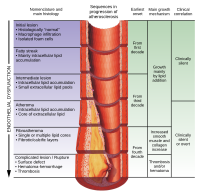
Photo from wikipedia
Myeloid cells assume a wide range of phenotypes, some of which are protective against injury and infection whilst others promote cardiovascular disease. This heterogeneity is partially caused by switching of… Click to show full abstract
Myeloid cells assume a wide range of phenotypes, some of which are protective against injury and infection whilst others promote cardiovascular disease. This heterogeneity is partially caused by switching of cell sources from local tissue‐resident macrophage proliferation to recruitment of circulating cells, and partially due to macrophages’ phenotypic plasticity. While long‐lived tissue‐resident macrophages support development, tissue homoeostasis and cardiac conduction, monocyte‐derived cells may promote destruction of the arterial wall and the myocardium, leading to organ ischaemia and heart failure. Influencing myeloid cell flux and phenotype shifts emerges as a therapeutic opportunity in many disease areas, including atherosclerosis, acute myocardial infarction, heart failure and stroke. However, it is currently unclear which cell subsets and drug targets are the most efficient and safest options. Here I review the neutrophil and macrophage supply chain and the cells’ emerging heterogeneity in the setting of atherosclerosis and ischaemic heart disease.
Journal Title: Journal of Internal Medicine
Year Published: 2019
Link to full text (if available)
Share on Social Media: Sign Up to like & get
recommendations!